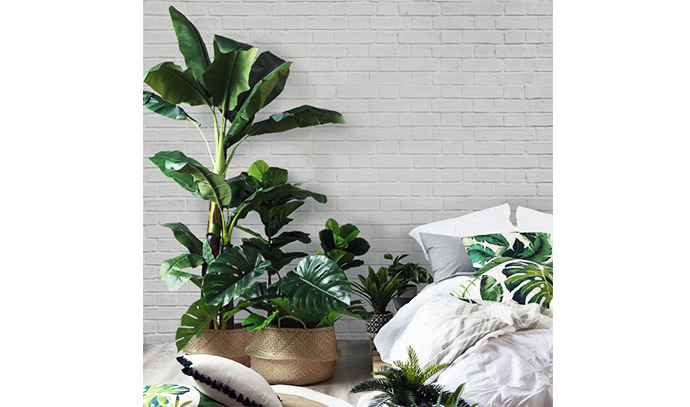5 simple styling tips for indoor plants
 Air plants get all of the water and nutrients they need through their leaves. Image via Elise Blaha Cripe[/caption]
1. Think outside the pot
Air plants get all of the water and nutrients they need through their leaves. Image via Elise Blaha Cripe[/caption]
1. Think outside the pot
Air ferns are not only gorgeous, but they don’t need water (just set and forget). This makes them ideal in places where you don’t want any liquid dripping down onto the furniture or carpet below – like above your bed. They can be placed on or in any sort of container or structure, but using something natural such as a beautiful piece of driftwood creates an elegant and restful ambience that’s perfect for the bedroom.
[caption id="attachment_6359" align="aligncenter" width="690"] Numerous plants thrive in the moist conditions found in wet areas. Ikea bathroom via Interior Gardens[/caption]
Numerous plants thrive in the moist conditions found in wet areas. Ikea bathroom via Interior Gardens[/caption]
2. Go troppo in the bathroom
Despite our best efforts, the bathroom is a naturally moist and steamy place – just like the tropics. So why not take advantage of the atmosphere with a humidity-hungry orchid. Other options include aloe vera, begonia, English ivy and philodendron.
Bathrooms tend to be on the smaller side, so space for greenery is often limited. Large or tall plants don’t often work in bathrooms for this reason. A better option is to choose plants that can hang from the ceiling, or will trail down from a high shelf. The windowsill is another great location for bathroom plants, particularly as they can enjoy maximum light exposure here.
[caption id="attachment_6357" align="aligncenter" width="690"] Group plants with varying heights, colours and textures for a dynamic indoor feature. Image via Christina Onsgaard[/caption]
Group plants with varying heights, colours and textures for a dynamic indoor feature. Image via Christina Onsgaard[/caption]
4. Breathe fresh air as you sleep
The great thing about indoor plants is that they remove carbon dioxide from the air and replace it with nice fresh oxygen that can ensure an extra good night’s sleep. Trade a bedside lamp for a rich, leafy fern that will turn a neutral space into a minimalist enchanted forest. Remember that trailing ferns don’t necessarily have to hang from the ceiling, they can look glorious in a pretty glass bowl that allows them to tail gracefully over the edges of the bedside table.
Another option is to go giant and fill an empty corner of the bedroom, bathroom ensuite or living area with the large, leathery leaves of a tall fiddle-leaf fig.
[caption id="attachment_6361" align="aligncenter" width="690"] Group monsteras, banana and fiddle trees for a lush, tropical look. Image via Pillow Talk. [/caption]
Group monsteras, banana and fiddle trees for a lush, tropical look. Image via Pillow Talk. [/caption]
4. Offset the neutral
Neutral, minimalist and industrial interiors are popular, so the green of plant life can stop an interior from becoming too drab by drawing the eye of the observer to its colour and life. There are two options here: either place plants in neutral containers (painted, natural clay or wicker) in order to keep the greenery as the star of the show, or make a bold statement with a bright contrasting colour such as red or yellow.
5. Create a vignette
A vignette is a small but powerful scene, so why not set the tone as soon as visitors walk in the door with a grouping of plants on an entry table. Mini cacti and succulents are like intriguing little scuptures that tell a story. Mix round, pointy, shiny, and matte plants, but, as with any eclectic arrangement, bring them together using pots that share a common colour, material or shape.
Here's how you can create a plant vignette in a few easy steps: [embed width="" height=""]https://www.youtube.com/watch?v=Yk5CloLmDAg[/embed] Top image via Pillow Talk


